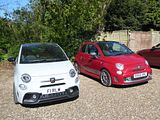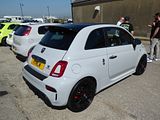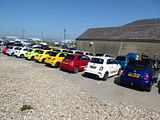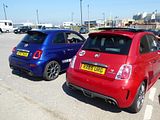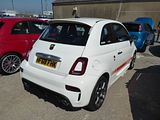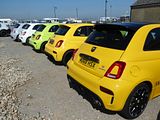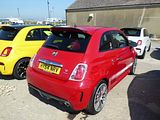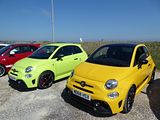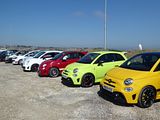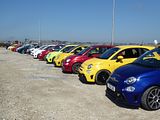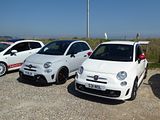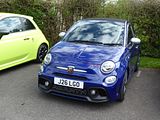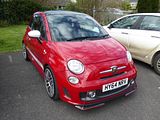It has been observed more than once that if you get actively involved with a Car Club not only will you see plenty of cars and meet lots of new people but you will almost certainly improve your knowledge of the geography and culture of Britain. As I know from experience, event organisers work tirelessly in finding new venues that are keen to welcome anything from a handful to a large number of cars, and the outcome of this planning means visiting all sorts of places that you likely have never been to before. When this event, organised by the B.A.D. Abarth South Coast (Bournemouth and Dorset) announced an event that would involve driving down to Portland Bill, with a particularly stunning photo of the lighthouse there on the event post, I did not hesitate long before putting in my diary which thankfully was clear for the day, knowing I was in for a day with plenty of Abarths, some good company and some great Dorset scenery. That Easter 2022 was blessed with fabulous weather was an added bonus that no-one could have planned for but which would prove very welcome on the day.
A SMALL ASSEMBLY IN SHAFTESBURY
As is often the case with events like this, a number of sub-groups assemble and then drive in as close a convoy as can be managed (not always easy!) to the main rendez-vous and I decided to take advantage of one of these. A meeting point in Shaftesbury was absolutely perfect for me, as I would be passing anyway and I knew from a previous B.A.D. event that the hotel car park that had been specified was a good place to gather a few Abarths together. In the end, just 4 Abarths came here. In true Abarth fashion, the four cars that met up here were all different both in detail and colour and everyone else was slightly later than had been arranged.
ASSEMBLING EVERYONE IN DORCHESTER
The first official meeting point for everyone who had signed up to the event was in the Tesco car park on the outskirts of Dorchester. Although we were a little late leaving Shaftesbury, I had assumed that we would still reach Dorchester with ample time to spare. But travel across Dorset tends to be quite slow, with meandering country A roads, and as this was Good Friday, a significant volume of traffic. In the end, we were late. We arrived to find a car park which is not that large pretty packed out with Abarths and people who were actually shopping. Most of the Abarths were grouped together and there was a good opportunity to see just what was parked up here.
The vast majority of cars were the 500-based models which have been on sale now since the end of 2008, following a launch at the Paris Show that year. Since that time there have been a number of detailed changes to the standard cars and a lot of limited editions. Those who really know the marque can spot most of them, but some are so subtle that unless there is a badge you can see, you will not be quite sure which version you are looking at. It used to be relatively easy, when the model was first launched, as there was only one version as shipped ex works called the 500. It had a 135 bhp 1.4 litre turbo-charged engine coupled to a five speed manual gearbox, with 16″ alloys as standard, and the option of 17″ wheels, and a colour palette comprising of two whites (BossaNova White, the standard colour, or the pearlescent Funk White), Red (Pasadoble), Pale Grey (Campovolo) or Black. If you wanted more power – 160 bhp – then you could order an Esseesse kit, which came in a large wooden crate, containing new wheels, springs, an ECU upgrade, the Monza exhaust system and badging. It was dealer fitted and could be applied at any time within the first 12 months or 10,000 miles from registration. Needless to say, it proved popular. As were many of the optional extras, with stickers for the sides, a large scorpion for the bonnet and even a chequered pattern for the roof among the personalisation options offered. There were not many of those original cars here, not least because sales volumes in the early years were much lower than they are now, and of course those first cars are now well over ten years old.
Having used the legendary 695 badging from the 1960s on the Tributo cars, at the 2012 Geneva Show, Abarth dusted off the 595 name that had been used on the less powerful of the Nuova 500 based cars of the same generation, and created two new versions which we should think of as Series 2 cars, the 595 Turismo and Competizione, both of which could be bought in either closed or open top C guise, with either the 5 speed manual or robotised automated gearshifts. Both models had the 160 bhp engine as standard. Effectively they were a replacement for the Esseesse kit, and it meant that the cars were produced complete at the factory, rather than needing the dealer to undertake the upgrade (and the associated paperwork), though Abarth did not withdraw the Esseesse kits from the market for some while. Turismo, as the name suggests was aimed slightly less extreme in intent, featuring standard leather upholstery, upgraded dampers and climate control, Xenon headlights and Alutex interior details. The sportier Abarth 595 Competizione replaced the leather seats with Sabelt cloth sport seats and Alutex with aluminium, while adding p-cross-drilled brakes and the Record Monza dual-mode exhaust. Some new colours were introduced, and very soon one of those, Record Grey, frequently combined with a tan interior became one of the most popular choices.
Rumours started to circulate towards the end of 2014 that Abarth were going to upgrade the Competizione model, so as better to bridge the gap between the Turismo and the 190 bhp 695 Biposto that had been added to the range earlier in the year. It was Geneva 2015 when the result was finally shown to an expectant fan base. Most exciting news was that thanks to a bigger Garrett Turbo, the engine had been tweaked to 180 bhp, and with reduced CO2 emissions. A standard spec that included Koni Dampers, Brembo brakes, Xenon lights, Sabelt seats, Climate Control, parking sensors as well as other refinements that had been added like the TFT instrument display all proved very compelling, so not long after the first cars reached the UK in June of 2015, I found temptation too hard to resist, and as is well documented here, swapped my 2010 car for one of these. At the time I ordered it, Cordolo Red, a tri-coat pearlescent paint which shimmers in bright sunlight looked set to become one of the most popular colours of the lot, even though it is a cost option. Indeed, the Launch Edition models were all offered either in this colour or Scorpion Black, with black wheels. Surprisingly, the colour was not carried over to the Series 4 cars.
What is known as the Series 4 version of the familiar 595 reached the markets in the middle of 2016. After rumours had circulated all winter following the launch of the facelifted Fiat 500 last year, Abarth finally unveiled the Series 4 at the end of May 2016. Initially, we were told that the cars would not be available in the UK until September, but that came forward somewhat, with dealers all receiving demo cars in June, and the first customers taking delivery in July. Three regular production versions of both the closed car and the open-topped C were initially available, all badged 595, and called Custom, Turismo and Competizione, as before, though numerous limited edition models have since appeared and in most case disappeared. The most significant changes with the Series 4 are visual, with a couple of new colours, including the much asked for Modena Yellow and a different red, called Abarth Red, which replaces both the non-metallic Officina and – slightly surprisingly – the tri-coat pearlescent Cordolo Red. as well as styling changes front and rear. The jury is still out on these, with many, me included, remaining to be convinced. At the front, the new air intake does apparently allow around 15 – 20 % more air in and out, which will be welcome, as these cars do generate quite a lot of heat under the bonnet. Competizione models for the UK retain the old style headlights, as they have Xenon lights as standard, whereas the Custom and Turismo cars have reshaped units. At the back, there are new light clusters and a new rear bumper and diffuser. Inside, the most notable change is the replacement of the Blue & Me system with a more modern uConnect Audio set up, which brings a new colour screen to the dash. Mechanically, there is an additional 5 bhp on the Custom (now 145) and Turismo (now 165 bhp) and the option of a Limited Slip Diff for the Competizione, which is likely to prove a popular option. Details of the interior trim have changed, with a filled-in glovebox like the US market cars have always had, and electric windows switches that are like the US ones, as well as a part Alcantara trim to the steering wheel in Competizione cars. These cars have now been on offer for five years and with Abarth sales on the rise, it was no surprise that they were particularly well represented here.
There were three examples of the Abarth Punto here, too. The Abarth Grande Punto debuted at the 2007 Frankfurt IAA Show, going on sale in the UK in late summer of 2008. Offering 155 bhp from its 1.4 litre T-Jet engine, coupled to a six speed gearbox, and riding on 45 profile 17″ alloys, the standard car got rave reviews from the journalists when they first tried it, and they were even more impressed by the changes wrought by the optional Esseesse kit. This increased power to 177 bhp, brought 18″ OZ lower profile wheels, whilst new springs lowered the ride height by 15-20mm, and high-performance front brake pads and cross-drilled front disc brakes helped the car to stop more quickly. The most distinctive feature of the car were the white alloy wheels, though, as owners found, keeping these clean is not a job for the uncommitted, and many have a second set of wheels that they use fro grubbier conditions. Despite the positive press at launch, the car entered a very competitive sector of the market, and the combination of being relatively unknown, a limited number of dealers and the existence of established rivals from Renault and others meant that this always remained a left-field choice. The owners loved them, though, and they still do. The oldest cars have now had their 11th birthdays, and some have amassed relatively big mileages, but they are still a car for the cognoscenti. There were two here, both well known in the community. The turquoise blue one belongs to Gavin Jenkins, and has been heavily modified both mechanically and visually. The other one belongs to Michael Meares and is one of a number of Abarths he has.
There was also one example here of the Punto Evo. This was launched at the 2010 Geneva Show, with the cars reaching UK buyers in the summer of that year, and it incorporated many of the changes which had been seen a few months earlier on the associated Fiat models, the visual alterations being the most obvious, with the car taking on the nose of the associated Fiat, but adapted to make it distinctively Abarth, new rear lights and new badging. There was more to it than this, though, as under the bonnet, the T-Jet unit was swapped for the 1.4 litre Multi-Air, coupled to a 6 speed gearbox, which meant that the car now had 165 bhp at its disposal. Eventually, Abarth offered an Esseesse kit for these cars, though these are exceedingly rare. For those in the know – which never seemed to be that many people – this was a really capable and desirable car, and the owners love them, lamenting the fact that the model had quite a short production life and has not been replaced.
It took some while for everyone to say their “hello’s”, introduce themselves to those who they’d not previously met, take advantage of the supply of Easter Eggs that Dawn Williams was handing out and then finally go back to their cars, ready for the off.
CHESIL BEACH
The first declared stop was Chesil Beach. The idea was to drive the cars in convoy there, and it should have taken around 40 minutes. Although the turn out of Tesco’s onto the main road was a left turn, even getting more than a couple of cars out at a time was hard. And then a few hundred yards further on, there was a roundabout and here the cars got somewhat broken up. My best efforts to try to follow someone who knew exactly where we were going came to an end within a few hundred of yards of setting off. For a while I could see a group of Abarths that were ahead of me, but thanks to some rather slower moving traffic, it was not that long before they all disappeared. Surprisingly, there was no-one much I could see behind me, either. Undeterred, I continued, knowing where I though we were going to meet (as per the instructions), but as I headed down the causeway with the parking for Chesil Beach to one side and saw no Abarths parked up, I began to wonder. Looking for somewhere to stop, I continued another few hundred yards and turned off into a side street. Having consulted the instructions again, I set off back to the road which would ultimately lead to Portland Bill and spotted a few Abarths parked up not quite where I was expecting to see them. I pulled in to find most of the group there. What a relief! This proved to be a great place to park up and get photos, with a huge stone barricade which we could scramble up to get some pictures from a height. That kept us occupied for a while. Scrambling down the pile of stones was a lit harder than going up it had been.
Next destination was the car park I had driven past and where there had then been no Abarths. By going right to the end of it, we realised we could line all the cars up, again perfect for another whole load of photos, though of course the line was so long that you could not actually get them all in one picture.
UNDERWAY AGAIN
By now we were only a few miles from Portland Bill, and the traffic was a little less, so I figured it ought to be easier to keep the cars in some semblance of a convoy. But we did all have to make a right turn out of the car park and there was enough traffic that this was not that easy. This gave the opportunity for some more photos, of course.
PORTLAND BILL
As we headed south, towards the peninsula that is Portland Bill the brilliant blue sky clouded over, with a band of sea mist, which was a shame. Pleasingly, we seem to drive through that, and I thought that when we got to the Bill, we would be able to get some great photos. Sadly that was not the case, as there was another band of sea mist that was blanketing the Bill, and the car park. Not withstanding that, it was busy and we had to park the cars where there were spaces rather than getting them all together.
Whilst we were here, there was a fun and informal competition with prizes against a series of categories from best presented car to most unusual. Everyone had a vote, and choosing was a more or less impossible task. Thankfully, no-one took it that seriously so the winners were congratulated without anyone moaning about the result. Whilst this was going on, the cameras were busy and these shots of Liam Oldcroft showing that to get some interesting views you sometimes need to resort to less than obvious positions.
Local resident Luca Klimmt did say that sea fog is a pretty common occurrence right on the coast, but often it blows over. Sadly, on this occasion, it did not so could barely see the lighthouse, though there was no doubt it was there as the fog horn did keep sounding, which I guess is the whole point of a lighthouse.
In fact, when we left and headed back, we saw that it had spread further north and the parking area at Chesil Beach where we had got some great pictures was now also in the misty area.
TIME FOR FOOD
Some people saw Portland Bill as the end of the event, but many of the group had signed up to what you could call a very late lunch or an early evening meal at a pub called The Thimble Inn in the intriguingly named Piddlehinton. This is a delight, though you would be unlikely to find it by accident, as it is down windy country lanes some way off the main road back towards Shaftesbury or Yeovil. It came highly recommended by Rob McCarthy and he was not wrong, with a glorious setting and excellent food. With the sunshine proving tempting, I stayed longer than planned and the it dawned on me just how far – in time, if not miles – I was from home. Sure enough, although the traffic had now finally died down, it was well over two hours to get back home, by which time it was dark.
This really was an excellent event. It ticked every box, really, with a varied array of interesting cars, some enthusiastic and friendly owners, some good driving roads and fabulous scenery, plenty of stopping points to regroup and take more photos, and an excellent pub at the end of it all to help sate our hunger and thirst. I stayed a lot longer than planned, always a good indication of how appealing an event is, though it was quite late when I got home, which was not entirely my plan as I knew I had an early start the following morning for another event. That the weather was perfect apart from that annoying sea mist at Portland Bill itself. The detailed planning of the day was all masterminded by Dawn Williams. It was her first event, a fact which she said had made her a little nervous. We all said that she had set the bar high and that she would surely be asked to organise more!









